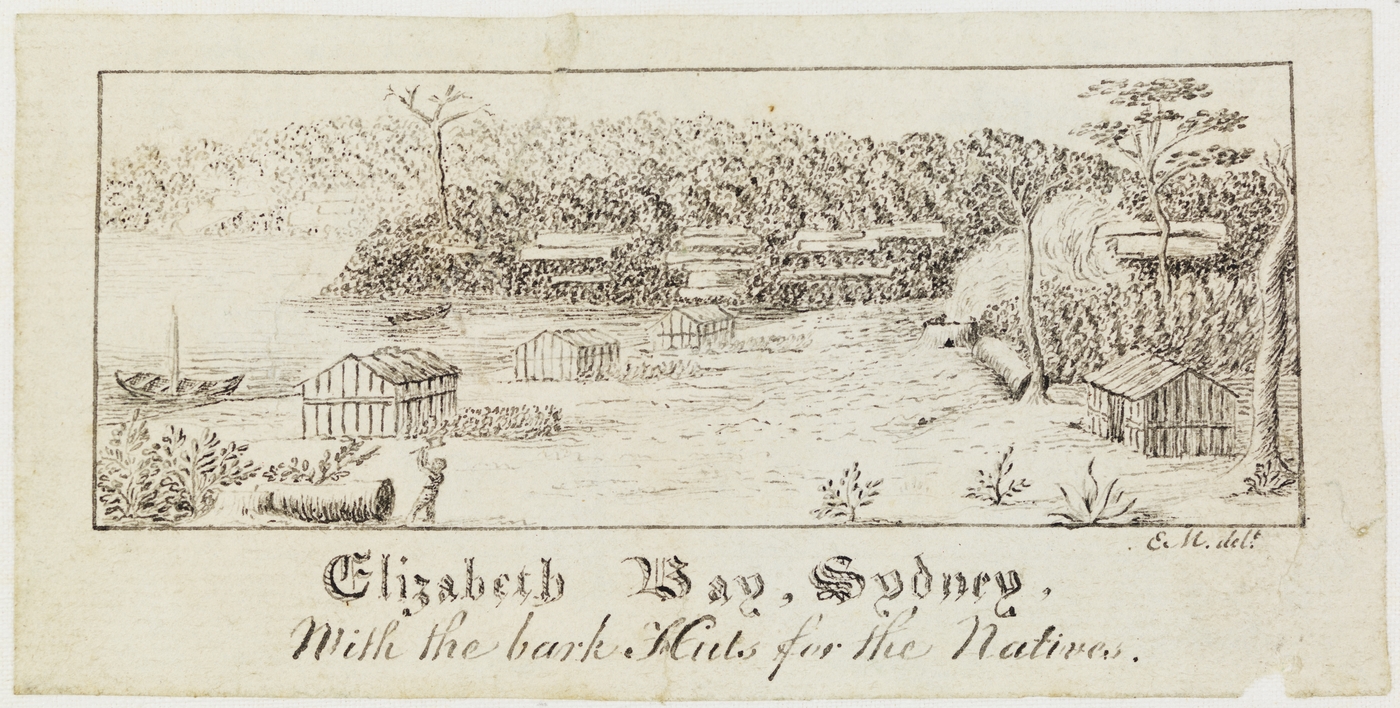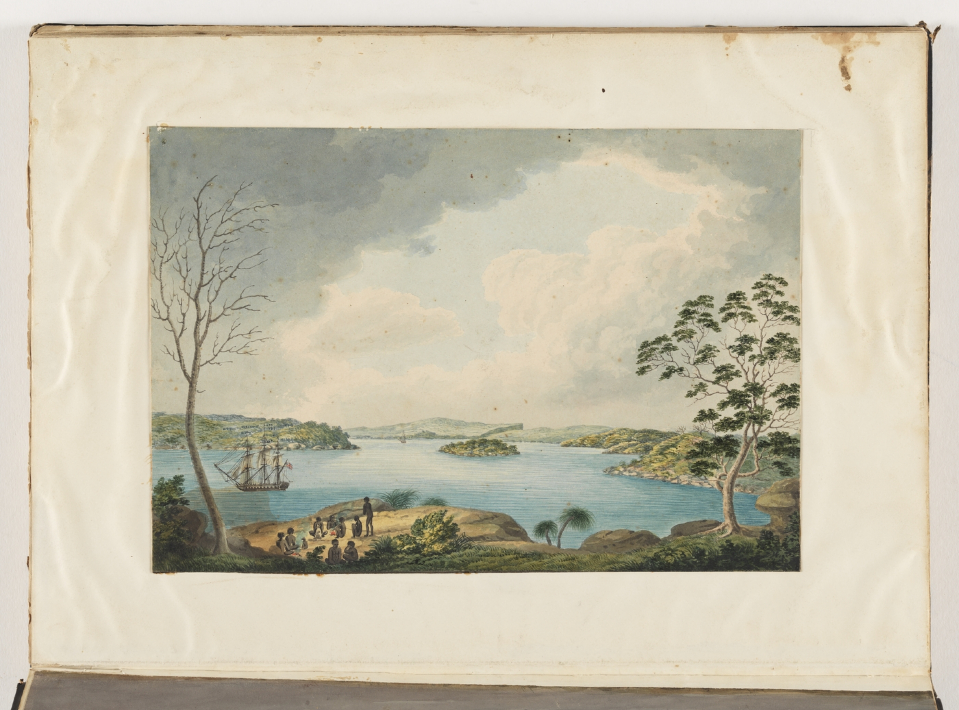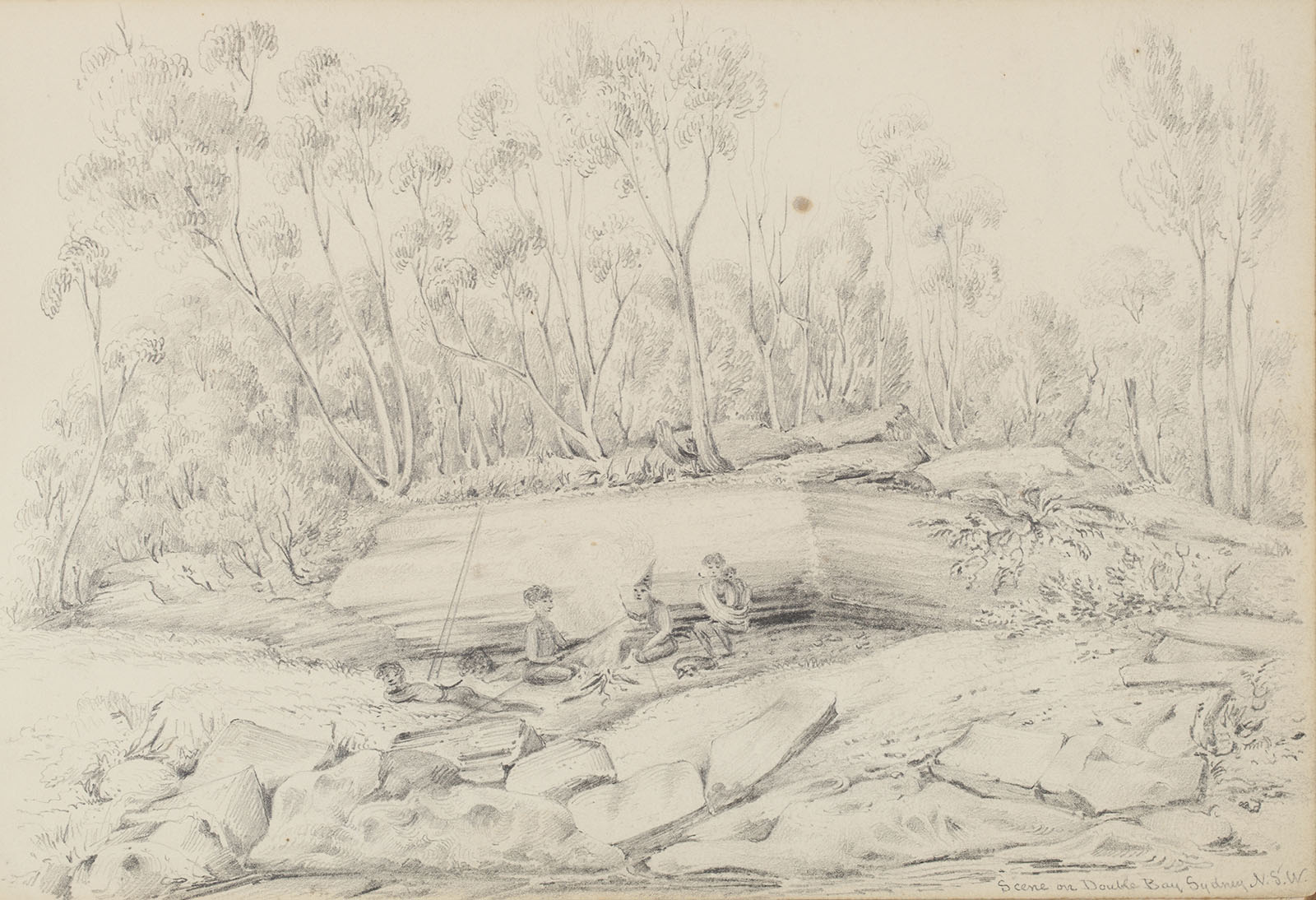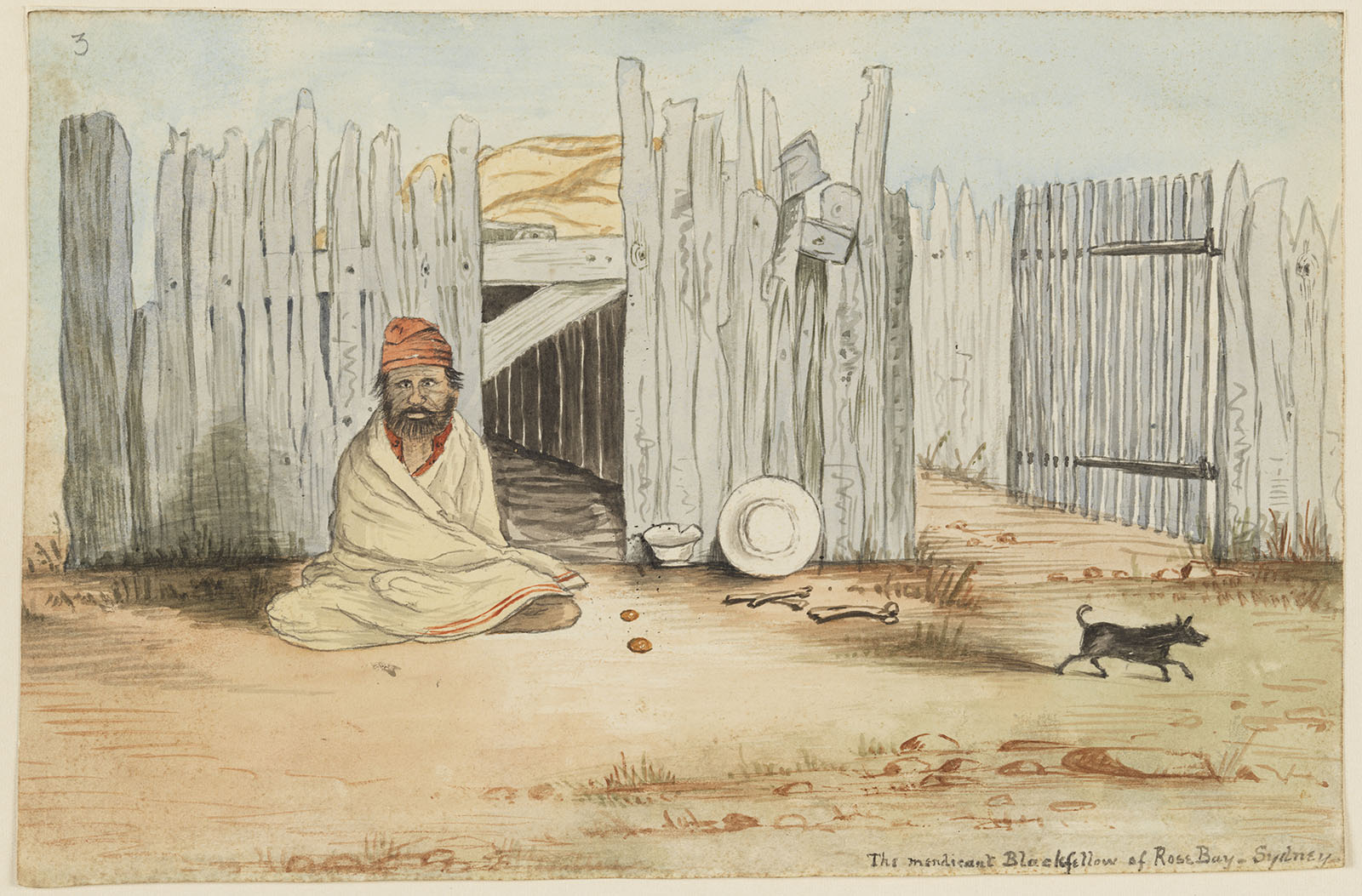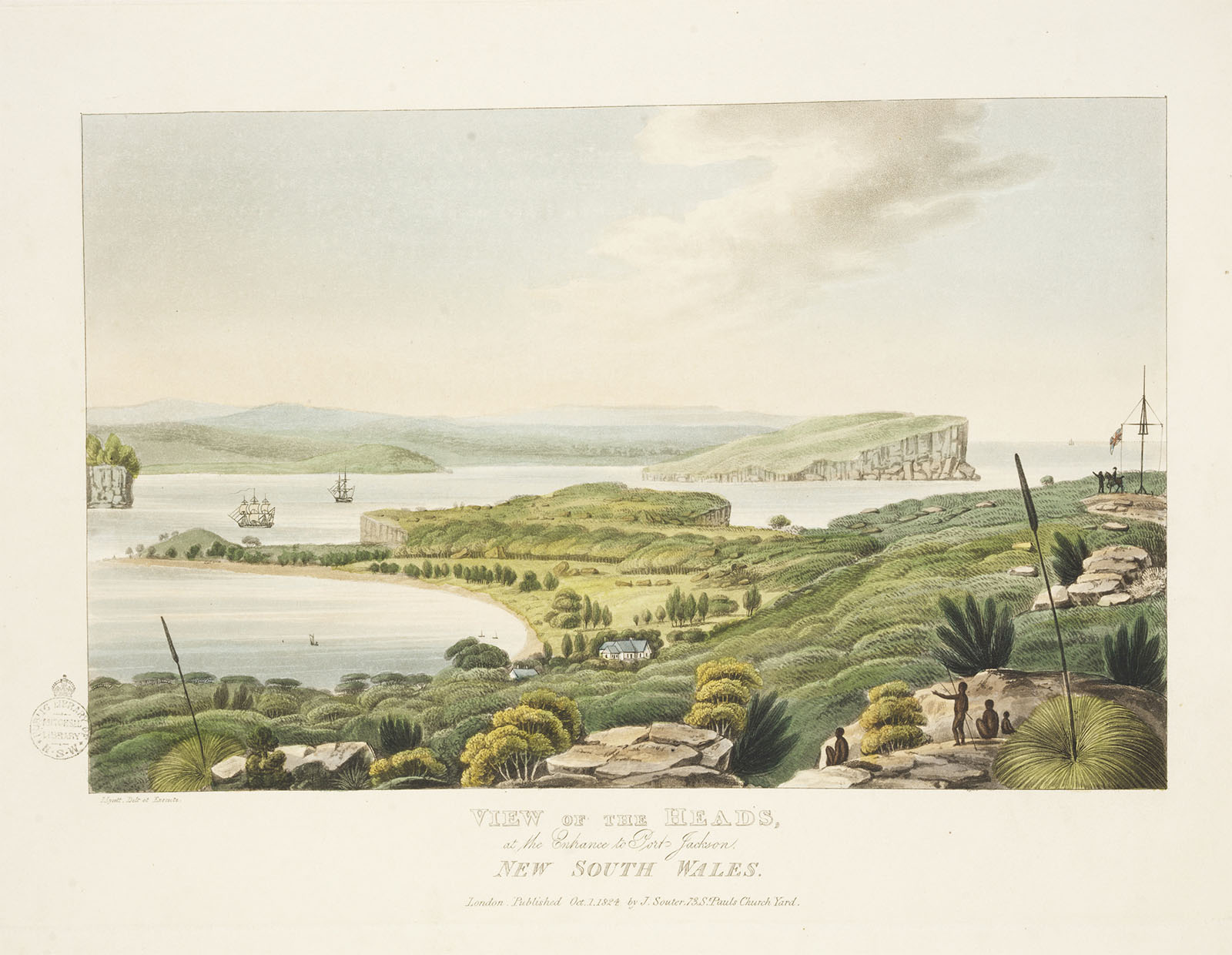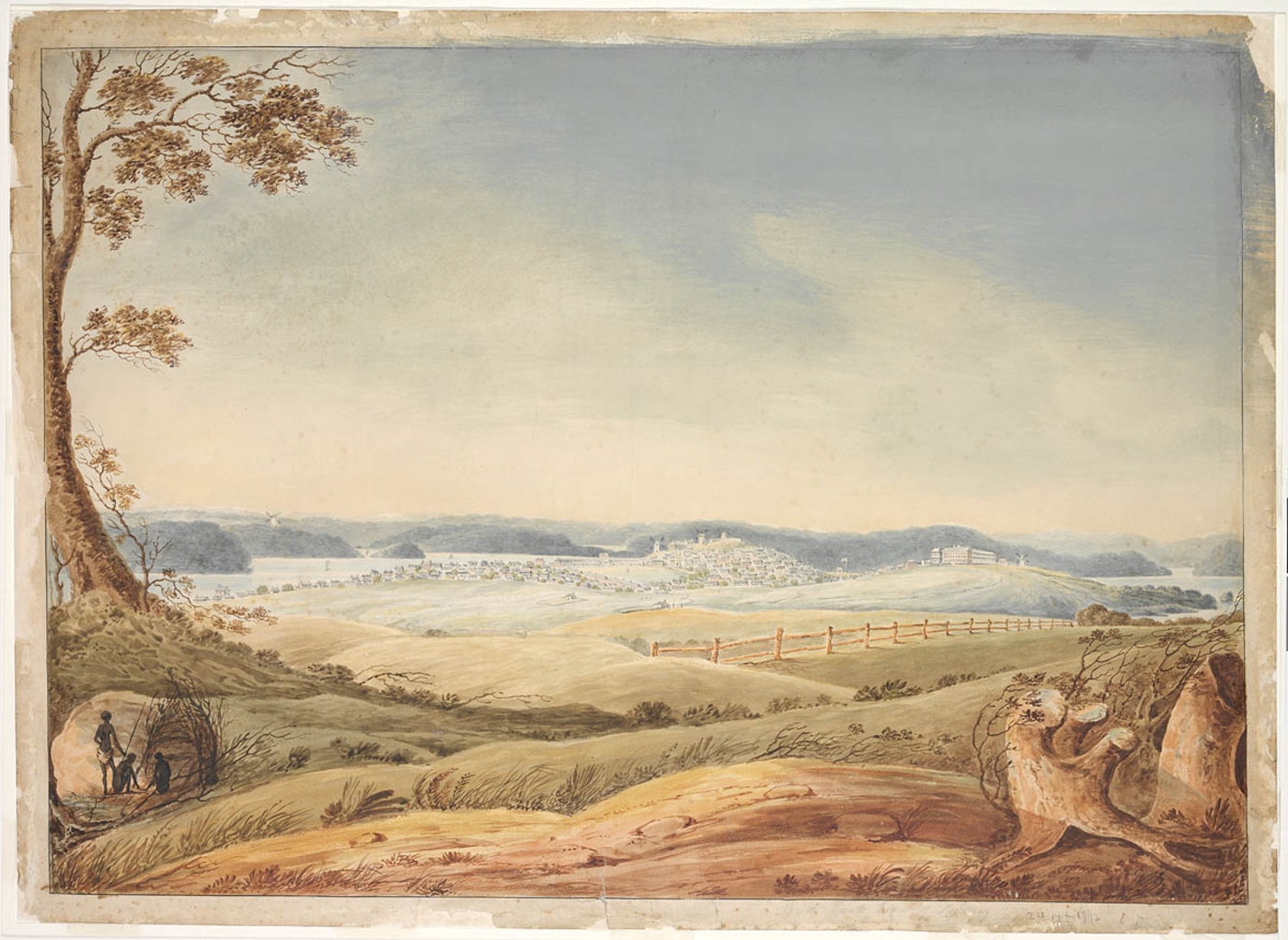The Dictionary of Sydney was archived in 2021.
Aboriginal life around Port Jackson after 1822
Citation
Persistent URL for this entry
To cite this entry in text
To cite this entry in a Wikipedia footnote citation
To cite this entry as a Wikipedia External link
Aboriginal life around Port Jackson after 1822
Despite dispossession, dispersal and decimation from disease, groups of Aboriginal people continued to live in sparsely settled areas around Port Jackson for more than a century after European occupation.
[media]Before leaving the colony of New South Wales in 1822, Governor Lachlan Macquarie established 'official' settlements for Aborigines of the 'Sydney Tribe'. He had huts built and provided a fishing boat and tackle for 42 'settlers' at the 'Native Village' at Elizabeth Bay. [1] With great optimism, Macquarie built new huts to revive the 'farm' he had first set up in 1815 at Georges Head (near Mosman) for Bungaree and his Broken Bay people. On Monday 11 February 1822, one day before his departure for England, the Governor and his wife Elizabeth went by barge to Georges Head to farewell Bungaree. Macquarie introduced Bungaree to his successor Sir Thomas Brisbane, who, wrote Macquarie, 'has, also, at my request promised to give Boongarie [Bungaree] for himself and his Tribe a Fishing Boat with a Nett'. [2]
[media]By this time, Eora descendants had established many unofficial camps around Sydney Town and its harbour. Those remaining had become fringe-dwellers, forced into unpopulated niches by the expansion of white settlement. Having lost their traditional territories, they now competed with the new arrivals for fish, game and even fresh water. They were compelled to choose either to move from settled areas or to find ways to adapt to the new conditions.
Remnants of different clans banded together in mixed groups, ignoring old enmities and origins. With official encouragement, they could obtain some of the benefits of 'civilisation', such as blankets, clothing, iron hatchets and fishhooks, and bread, flour, sugar, tea, tobacco and alcohol, to which they quickly became accustomed.
Their resulting lifestyle was a mixture of tradition and adaptation. The French pharmacist Réne Primavere Lesson wrote:
The tribes today are reduced to fragments scattered all around Port Jackson, on the land where their ancestors lived and which they do not wish to leave.
He mentioned in particular:
the tribe of Bongarri [Bungaree] or of Sydney Cove … that of Parramatta, under the control of Hari [Harry], that of Cow Pastures, whose chief was called Cogue [Cogie]… [3]
To obtain access to harbour fishing, these family groups searched for campsites close to the shore and near a creek or other source of fresh water. Around their fires, they could still sit naked, collect bush foods, fish and swim, tell stories and sing songs as before. When they went into the settlements to barter fish or seek supplies, they were required to put on European clothing.
Historical records of this period are few and scattered, but when viewed together, they provide a picture of where and how, over generations, Aboriginal families were able to eke out a living. References to Indigenous people camping around Port Jackson who came from outside the Sydney area begin in the late 1820s and increase throughout the nineteenth century. By that time, very few were Eora descendants.
Several reports referred to the 'last' member of 'the Sydney tribe', reflecting the European conviction that Aborigines were destined to 'die out'. There is sufficient evidence to identify campsites at the freshwater creeks running into the southern side of Port Jackson inside the former boundaries of the Cadigal (today's eastern suburbs and City of Sydney).
Point Piper
In 1819, French naval lieutenant and draughtsman Jacques Arago from the corvette Uranie visited Captain John Piper at his elegant home at Point Piper. Arago passed a small creek in which were 'five or six little canoes', where a group of Aborigines were leaping, dancing and clapping their hands around a woman lying on kangaroo skins as she gave birth to a child. When the baby was born, the mother got into one of the canoes and dipped the child several times in the salt water. Arago gave her a handkerchief and cravat. [4] The creek at Point Piper now hardly exists and the family Arago saw was likely to have been the genesis of the later 'blacks' camp' at Rose Bay.
In the winter of 1822, Piper sent a petition to Governor Sir Thomas Brisbane on behalf of a group of Aboriginal people camped nearby, who had asked him for clothing or blankets:
Petition of the Natives at Point Piper
To Governor Brisbane &c. &c.
Point Piper
from John Piper, July 1822
To His Excellency Sir Thomas Brisbane etc. The Humble Petition of the under mentioned Black Natives of New South Wales, Humbly Sheweth,
That Petitioners have no other residence but their natural woods near Sydney, and at this … season of the year are almost in a state of nudity, suffering Cold and hunger in the extreme.—
In order to supplicate your Excellency for relief They solicited a White Man to put their unfortunate situation in writing for your Excellencys humane consideration, and as your Excellency has extended your benevolence to several of their suffering brethren, they humbly hope your Excellency will allow them some sort of covering from His Majestys store. and Petitioner will ever pray.
Harry
Balmain
Krankie (1st)
Krankie (2nd)
Punch
Maria
Peggy [5]
The individuals in this diverse group originally came from different parts of the Sydney area. Bennelong's brother-in-law Harry was 'chief' of Parramatta, Balmain or Bulmanna was from Botany Bay, Punch was the wife of Cullabaa from Brisbane Water and Maria, also from Brisbane Water, might have been the wife of Bowen Bungaree. Krankie (1st) was probably Harry's wife Carangarang (Bennelong's sister) while Krankie (2nd) might be Carangarany, later called Cranky or Panky.
Darling Point
In 1903 Mrs Elizabeth Phillip, then aged 96, recalled that in her childhood:
The blacks in that time were numerous, and I have often seen hundreds of them camped on what is now known as Darling Point; [they were] as kind people as ever lived. Whenever they speared fish they used to bring us some. [6]
Yerinibe or Yeranabe (Yeranibe Goruey), though born a Burramattagal (member of the Parramatta clan), was said to be 'King' of the Darling Point 'tribe' in the 1830–40 period. He is commemorated by Yarranabbe Road, Darling Point and Yarranabbe Park, Rushcutters Bay. [7]
Rushcutters Bay
According to Obed West, the land running down to Rushcutters Bay (Barcom Glen) was
a great camping place for the blacks, particularly the slope on the Darlinghurst side, and even to a recent period the blacks had a lingering fondness for the old camping ground. In former days [1830–40] I have watched them in their canoes in the bay, the gins fishing with the line while their sable lords used their spears to get the fish that swam beneath them. [8]
Rushcutters Creek, a freshwater stream, flowed through Lacrozia Valley, from about Victoria Street, through Barcom Glen (where West lived) and over the present New South Head Road into the bay. Writing in 1924, Arthur Dowling recalled that West's property was
covered with bush and large gum trees. This bush was the resort of semi-civilised aboriginals, chiefly half-caste, where they had formed a large camp, which was a nuisance to the neighbourhood. [9]
It was stated in evidence at an inquest into the death of an Aboriginal woman named Maria who died in the Sydney Infirmary in 1850 that she had previously lived in a paddock at Rushcutters Bay. [10]
Double Bay
Leopold Verguet, a French Marist Catholic missionary, described a 'tribe' led by Tamara 'in their camp under a rock at Double Bay' in 1845. There were about 20 Aboriginal men, women and children in this group, wrapped in blankets and huddled around a campfire with their dogs. They smoked tobacco in pipes, drank ‘bull’ (watered-down rum or brandy) and wore cast-off European trousers, jackets, hats and scarves.
Tamara's small clan lived by spearing fish in Port Jackson, begging, and gathering gum from eucalyptus trees, which the women sold in Sydney. One man carried several three-pronged fishing spears. Fresh water was available from the creek that now crosses New South Head Road through a stormwater channel at Cross Street, Double Bay. Verguet sketched Tamara, a woman, a child and a man named 'Belé, of the tribe of Tamara'. The other Aborigines, he writes, 'burst out laughing in recognising their chief on my paper'. [11]
In August the same year (1845), George French Angas painted a portrait of a melancholy-looking Tamara (Hand) dressed in a three-piece suit, standing barefoot on a rock. [12] Angas said Tamara was 'honoured by blacks and whites alike for his skill in shaping returning boomerangs'.
Tamara probably came from the south coast of New South Wales. In 1827 he was registered in Sydney as Thomas Tamara, father of Gertrude Tamara, whose mother was Narney or Nanny Nelolla. [13] Return of Aboriginal Natives records, however, show Thomas Tomain collected blankets in Sydney in 1835 saying he came from Bulli. In 1836 as 'Tomorrah' he was at Parramatta, claiming to live at Botany, yet the same year he was recorded as 'Tomarra' at Wollongong, picking up blankets with the Five Islands and Kiama tribe. [14]
[media]Amateur artist Henry Campbell drew a pencil sketch of a 'Scene on Double Bay', showing a group of Aboriginal men around their campfire and rock shelters; they were probably members of Tamara's clan. One man wore his hair tied up in paperbark strips. [15]
Historian James Jervis said 'Old Wingle' from Port Stephens and his wife Kitty camped on a knoll above Double Bay, on a site that is now Ascham School, with 'Bondi Charley'. They sometimes gave demonstrations of boomerang throwing in return for copper coins. [16] Kitty died in 1859, aged about 26, from a 'chronic disease of the chest' in their bush camp near the Bayswater Hotel at Double Bay, where an inquest was held. Kitty came from Broken Bay and had previously worked as a servant in Newcastle and spoke English well. [17]
Jack Harris, who died in the Double Bay camp in 1863, was said to be 'a relic of the now nearly extinct Sydney tribe'. [18] Like Bungaree, who had died in 1830, Harris was fond of telling European settlers 'This is my country'. He was mourned by his widow Charlotte and buried in the Catholic Burial Ground in Sydney. [19] Harris and Old Wingle were among the crowd that welcomed William Charles Wentworth on his return to Sydney on the steamer Benares in 1861. [20] Wingle died of consumption at Botany in 1868. [21]
The Rose Bay camp
There was already an Aboriginal camp on the South Head Road outside 'The Cottage', home of Daniel Cooper, the wealthy Speaker of the Legislative Assembly, at Rose Bay in 1829. The Sydney Gazette of 26 September 1829 said 100 men, women and children inhabited this camp.
[media]For many years, an Aboriginal man nicknamed 'Ricketty Dick', crippled by arthritis, camped in a bark gunyah (hut) in front of the paling fence in front of Cooper's house, asking travellers on the South Head Road for a 'toll' of sixpence, one shilling or some tobacco.
When he died in 1863, he was identified as William Worrall (also Bill or Billy Warrall), originally from the 'Five Islands' or Illawarra, area south of Sydney. [22] Members of the 'Sydney tribe' who collected blankets in Sydney in May 1850 were identified as Gooseberry (Cora Gooseberry, widow of Bungaree), Bowen (Bowen Bungaree, his eldest son) and 'Billy Warrall'. [23]
In a letter to the Sydney Morning Herald in 1890, Phillip Cohen referred to a period 'more than forty years ago' (about 1850) when 'the black's camp … was at the time situated at Rose Bay'. [24] The camp was close to the grave of the Broken Bay leader Bungaree, who was buried in 1830 near the present Rose Bay police station, built as the gatehouse for Daniel Cooper's mansion Woollahra House.
While in Sydney, the English novelist of manners Anthony Trollope dined at Woollahra House (built on the site of John Piper's Henrietta Villa). Trollope was shown a rock in the grounds 'on which the blacks in the old days, when they were happy and undisturbed, used to collect themselves for festive, political and warlike purposes'. [25]
WH East recalled the bushland site at Bellevue Hill opposite Robert Town's property 'Cranbrook' on Old South Head Road in the 1870s
that sheltered a small tribe of aboriginals who were its only inhabitants, and absolutely loyal to their king Pankey [Krankie or Cranky], and his queen Rachael.
East claimed that Pankey's son Freddy had made many of the Aboriginal rock engravings that once existed at Point Piper. [26]
Bondi Beach
James Friday, Johnny Baswick and other Aboriginal men camped at Bondi Beach in 1873, where they fished off the rocks. [27] In 1874 'Bankey' (Krankie or Cranky) and Rachael lived with other Aborigines at Ben Buckler. RJ Stone, a Bondi surfing pioneer, said in 1924:
Yes it was about 50 years ago on a bright summers day that a party of we boys, stood on Bondi Beach watching the Blacks who were camped at Ben Buckler, enjoying the ocean waves, with their wives and children. Bankey, Timmy, Sandfly, Tilly, Rachael and others. And how we made them laugh when we said we would join in a corroboree with them ... [28]
In 1882 'Pankey' was said to be the only living Aborigine who remembered Harry. 'This old native resides about Rose Bay, and is often a visitor at Mr Dalley's', said a writer in Fuller's Rural Cumberland Year Book. [29] William Bede Dalley, barrister and politician, lived until 1881 at Clairveaux, overlooking Rose Bay.
In a talk on Aboriginal stone implements, Archibald Liversidge, a chemistry professor at the University of Sydney, told a meeting of the Royal Society of New South Wales in 1894:
Most of the implements from Sans Souci and Bondi were obtained by me from the few blacks who, some twenty years ago, used to camp at these places.
South Head and Camp Cove
[media]'One of the Aboriginal women, fishing outside the South Head on Monday, had her leg bitten off by a shark,' the Sydney Morning Herald reported on Monday 11 June 1832.
In December 1834, nearly 100 Aboriginal people were camped on the eastern shore of Port Jackson in rock shelters at Camp Cove, between South Head and Watsons Bay. According to William Proctor from the ship John Craig , they included Bungaree's sons Bowen and Toby, and Salamander and Bogy from Broken Bay, who made a living selling fish to ships' crews and guiding fishermen and hunters in exchange for money, food and alcohol. [30]
While in Sydney during 1845, the French missionary Leopold Verguet said it was 'not rare' to see gatherings of Aboriginal people near the entrance to Port Jackson. 'The rocks of the coast provide many caves there, where they can pass the night sheltered from bad weather'. [31]
In July 1845 Bungaree's widow Cora Gooseberry Bungaree was at Camp Cove when Police Inspector WA Miles and artist George French Angas enlisted her help to point out rock engraving sites in Port Jackson. Miles noted the mixed group of Sydney and Broken Bay people living there.
About a dozen natives of the Sydney and Broken Bay tribes were camped among the bushes on the margins of a freshwater lake close to Camp Cove, and from amongst them we selected Old Queen Gooseberry to be our guide, promising her a reward of flour and tobacco … [32]
Woolloomooloo and the Sydney Domain
Verguet mentioned two Aboriginal men who often slept the night in the bush at Woolloomooloo where he [media]was staying. [33]
George Thornton, the first Protector of Aborigines (from 1880) remembered an 'old Sydney aborigine named Krooi' from Botany Bay who during the 1830s had his camp at Yurong (Mrs Macquarie's Point). 'He used to fish from a small detached rock a few feet distant from the NE part of the point. It was known as Krooi's Rock.' [34]
Writing in 1916, Captain W Greaves, a former government surveyor, recalled:
At the bottom of Wooloomooloo-street, and at the back of the present Blind Institution was a creek that emptied its waters into Wooloomooloo Bay, a little east of Crown-street at Plunkett-street, now reclaimed land. In this vicinity in the bushy portions of the outer Domain, towards where the swimming baths are now situated, one might see the blackfellow and his gin in their gunyah; upon one's approach the worthy couple would commence the usual plea for 'bacca' [tobacco] and a pipe. [35]
On Christmas Day 1844, Charles Smith, a Sydney butcher, 'regaled the Aboriginal tribes of Woolloomooloo and Shoalhaven with a Christmas dinner' including roast beef, mutton, plum pudding and 'a moderate and judicious supply of ale, porter, and wine'. After they had shaved and washed, the Aboriginal male guests received a 'Christmas box' of a new shirt. [36] A few years before, in 1838, the kindly Charles Smith had covered the expenses of the surgeons who amputated the arm of the Aboriginal sealer and adventurer 'William Annam' (Willamannan or William Menan) at Sydney's Colonial Hospital. [37]
Greaves, who came to Sydney in 1852, saw Aborigines camping at Rushcutters Bay. 'But these were not Sydney blacks, as the Sydney tribe had almost entirely disappeared.' He said the Aborigines in the Domain had accompanied bullock teams that brought agricultural produce from the country. [38] Alexander Berry employed many Aborigines from the Shoalhaven on the south coast of New South Wales at his property 'Coolangatta'. Some went to sea as sailors or enlisted as mercenaries with John Batman's 'rovers' in Van Diemens Land (Tasmania), while others camped in the Sydney Domain.
Berry wrote in his Reminiscences:
A good many [from Shoalhaven] died in Sydney in consequence of drinking, a few in their native feuds of violence, and a good many from measles …
One of these was Wajin, chief of Shoal Haven, who was taken by Berry to Sydney by boat in 1822 and presented with a gorget:
Poor Wajin some years after got very drunk in Sydney. His tribe carried him to their camp at Woolloomooloo, but he died in the course of the night. [39]
When Jenny Poyne, aged 16, fell ill in June 1852, she was pushed in a wheelbarrow to Brady's hotel in Bourke Street, Woolloomooloo. According to the Sydney Morning Herald, 'Mr. B. [Brady] had known her for a long time, and had always been very kind to her and her tribe.' [40] Brady did what he could for the girl, until she died of natural causes.
Frederick Garling, who found the body of Thomas Potarlick lying under a blanket in March 1853, told an inquest at the Three Tuns Tavern that 'he and others of his tribe were in the habit of sleeping in the Government Domain'. Potarlick, an elderly Aboriginal man, had died of natural causes. [41]
Hyde Park
Aboriginal people who frequented the streets of Sydney often camped or slept overnight at the racecourse at Hyde Park, in the Sydney Domain, or at Woolloomooloo.
In 1833 a fist-fight in Pitt Street between Aboriginal and settler youths progressed to Hyde Park. 'One of the blacks quite a young man, fought courageously, and although much punished himself, afterwards completely beat his opponent,' the Sydney Herald reported. [42] In December 1842, a group of Aborigines walking across Hyde Park towards Woolloomooloo were pelted with stones by a gang of boys. [43]
William Menan or Manen, previously known as Willamannan (having taken his name from the ship William and Ann), died from exposure at the racecourse at Hyde Park on Wednesday 29 May 1844. A writer in the Dispatch newspaper outlined the circumstances of his death:
We cannot make mention of this circumstance, without expressing a severe censure on the conduct of Inspector Higgins, and Constable McKone, who took Menan from the door of a public house in Elizabeth or Castlereagh Street, helplessly drunk, and contented themselves with putting him inside the palings of the Race Course, there to die from cold and intemperance. [44]
Moore Park
[media]A watercolour scene titled 'Sydney from Surry Hills', painted by the prolific artist Joseph Lycett in 1819, pictured three Aboriginal people in their gunyah or bark hut with the buildings of the encroaching city of Sydney seemingly far off in the distance. [45]
An Aboriginal camp in Phelps Street, Paddington, close to the present Moore Park, was mentioned in various newspaper reports late in the nineteenth century. Those living there included Jerry Jumbler, Norah King and Ellen Kennedy. [46]
In November 1890, the wealthy Chinese tea merchant and businessman Quong Tart invited Aborigines living around Sydney to a feast at the Zoological Gardens, then at Moore Park. About 40 Aboriginal men, women and children came to the picnic on 26 November. The following day, The Daily Telegraph reporter wrote:
The blacks were principally from the camps at Botany and Moore Park – old gins, toothless and feeble, young lubras, piccaninnies, 'warriors,' and kings without kingdoms. [47]
Charley Murray, an elderly Aborigine 'whose English was almost perfect, grew quite excited as he praised Mr. Tart's generosity'. [48]
There was clearly an Aboriginal presence around Port Jackson until quite late in the nineteenth century.
Notes
[1] E Smith Hall to Sir George Murray, 26 November, 1828, Historical Records of Australia, vol 14, pp 596–8; Charles Bertie, Peeps at the Past, Sydney, 1914, p 39; Joseph Cross, 'Native Village', Map of The Harbour of Port Jackson, London, 1827
[2] Lachlan Macquarie, Journal, 1818–1822, 11 February 1822, State Library of New South Wales, Mitchell Library, MS A774, pp 258-60
[3] René Primavere Lesson, Voyage autour du Monde, sur la Corvette La Coquille, P Pournat Freres, Paris, 1838
[4] Jacques Arago, Narrative of a Voyage around the World, Treuttel, London, 1823
[5] Colonial Secretary Reel 6052; State Records New South Wales, 4/1753:159
[6] Newspaper Cuttings, 24 January 1903, State Library of New South Wales, Mitchell Library, vol 114, p 28
[7] Richard Hill and George Thornton, Notes on the Aborigines of New South Wales : with personal reminiscences of the tribes formerly living in the neighbourhood of Sydney and the surrounding districts, Government Printer, Sydney, 1892, p 7
[8] Obed West, 'Old and new Sydney', Sydney Morning Herald, 12 October 1882, p 9
[9] Arthur Dowling, 'Some Recollections of the New South Head Road and Woollahra', Journal of the Royal Australian Historical Society, vol 10, part 1, 1924, p 46
[10] Sydney Morning Herald, 3 August 1850, p 3
[11] Leopold Verguet, Histoire de la première mission catholique au vicariat de Mélanésie, Paris, 1861, 2nd edition, translated by Hugh Laracy, Aboriginal History, vol 4, part 3, 1980, pp 179–183
[12] In the Sydney language damira meant 'hand': 'Tamira - - - hand' – Anon, Vocabulary of the language of N.S. Wales in the neighbourhood of Sydney … School of Oriental and African Studies, London, Manuscript Book C, 1791 p 22.12; 'Tamurá - - - The Hand' - David Blackburn, List of native names, with English equivalents, A6163, Mitchell Library, State Library of New South Wales, Sydney 1791, p 18; Watercolour sketch by George French Angas "Old King Tamara. The last of the Sydney Tribe. Aug 15, 1845" held by South Australian Museum, AA8/4/2/2, III
[13] NSW Births, deaths and marriages, V1827927, 128/1827 and V1827899
[14] Return of Aboriginal Natives, State Records NSW
[15] Henry Campbell, Scene in Double Bay, State Library of New South Wales, Mitchell Library, c1840–44, PXC 291
[16] James Jervis, History of Woollahra, Woollahra, 1967, p 44
[17] Sydney Morning Herald, 19 September 1859, p 4; 26 September 1859, p 2
[18] Sydney Morning Herald, 1 December 1863, p 5
[19] The Empire, Sydney, 11 February 1863
[20] Sydney Morning Herald, 19 April 1861, p 5
[21] Sydney Morning Herald, 18 July 1868, p 5
[22] Sydney Morning Herald, 16 June 1863, p 4
[23] Sydney Morning Herald, 27 May 1850, p 2
[24] Sydney Morning Herald, 27 May 1890, p 2
[25] Anthony Trollope, Australia and New Zealand, London, 1876, p 228
[26] Sydney Morning Herald, 15 February 1930, p 13
[27] Sydney Morning Herald, 16 December 1873, p 6
[28] RJ Stone, quoted in B Dowd, The Centenary of the Municipality of Waverly: 1859–-1959, Council of the Municipality of Waverley, 1959, p 138
[29] CE Fuller (ed), Fuller's Cumberland Year Book, Parramatta, 1882, p 122
[30] William Proctor, A Landsman's Log … On board the John Craig, State Library of New South Wales, Mitchell Library, MS B1126, 1834
[31] Leopold Verguet, Histoire de la première mission catholique au vicariat de Mélanésie, Paris, 1861, 2nd edition, translated by Hugh Laracy, Aboriginal History, vol 4, part 3, 1980, p 180
[32] WA Miles, Journal of the Ethnological Society of London, vol 3, 1854 , pp 1–50
[33] Leopold Verguet, Histoire de la première mission catholique au vicariat de Mélanésie, Paris, 1861, 2nd edition, translated by Hugh Laracy, Aboriginal History, vol 4, part 3, 1980, p 180
[34] George Thornton, Notes on the Aborigines of New South Wales, Government Printer, Sydney, 1892, p 7
[35] Captain WAB Greaves, 'Recollections of Old Sydney in 1852 and since', Journal of the Royal Australian Historical Society, vol 111, 1916, pp 416–17
[36] The Australian, 27 December 1844, p 4
[37] Sydney Herald, 7 June 1838, p 3
[38] Captain WAB Greaves, 'Recollections of Old Sydney in 1852 and since', Journal of the Royal Australian Historical Society, vol 111, 1916, pp 416–17
[39] Alexander Berry, Reminiscences of the Aborigines, Supreme Court Miscellaneous Correspondence Relating to Aborigines, no 83, 1838, State Records NSW
[40] Sydney Morning Herald, 25 June 1852,
[41] Sydney Morning Herald, 2 March 1853, p 2
[42] Sydney Herald, 26 December 1833, p 2
[43] Sydney Gazette, 14 December 1842, p 2
[44] The Star, 8 June 1844; Dispatch, 8 June 1844, p 2c
[45] Joseph Lycett, Sydney from Surry Hills, 1819, watercolour, State Library of New South Wales, Mitchell Library, ML 54
[46] Sydney Morning Herald, 23 June, 1886, p 5; 22 July 1887, p 7
[47] Daily Telegraph, 22 November, 1890
[48] News, Sydney, 27 November 1890
.



